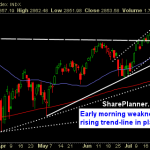The Moving MACD (Average Convergence Divergence) and RSI (Relative Strength Index) are two of the most popular indicators for forex traders. These two simple indicators measure the speed and change of price movements of a particular asset, such as a forex pair, commodity or stock index. In the following article, we’ll explore how the RSI and MACD can help with your trading.
RSI
The RSI is a momentum oscillator that fluctuates between zero and 100. Traditionally, the RSI is considered overbought when it exceeds 70 and oversold when it falls below 30. Forex pairs that have an RSI above 70 are probably overbought, which means they are prone to a downward correction. On the flip side, forex pairs with an RSI below 30 are oversold, and will likely correct higher in the short term.
In general, the RSI tends to remain in the 40 to 90 range during an uptrend, with the 40-50 band acting as a zone of support. During a bear market or downtrend, the RSI tends to fluctuate between 10 and 60, with the 50-60 region acting as resistance.[1]
MACD
The MACD is a trend-following momentum indicator that depicts the relationship between two moving averages. It is essentially calculated by subtracting the 25-day exponential moving average (EMA) from the 12-day EMA. Traders usually look for a crossover to determine a change in momentum or direction.
A crossover occurs when the MACD falls below the signal line (also referred to as a zero line). This is a bearish signal, which could be your cue to sell. When the MACD rises above zero, the indicator gives a bullish signal. This suggests it may be a good time to buy.
In addition to crossovers, traders also look for divergence – that is, when a forex pair diverges from the MACD. When this occurs, it usually means the end of the current trend.
Finally, traders use the MACD to determine overbought and oversold conditions. This occurs when the MACD experiences a dramatic rise (i.e. when the shorter moving average pulls away from the longer-term average).[2]
















Leave A Comment